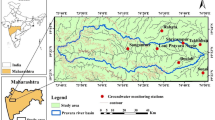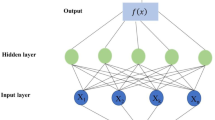Abstract
Prediction of water level is an important task for groundwater planning and management when the water balance consistently tends toward negative values. In Maheshwaram watershed situated in the Ranga Reddy District of Andhra Pradesh, groundwater is overexploited, and groundwater resources management requires complete understanding of the dynamic nature of groundwater flow. Yet, the dynamic nature of groundwater flow is continually changing in response to human and climatic stresses, and the groundwater system is too intricate, involving many nonlinear and uncertain factors. Artificial neural network (ANN) models are introduced into groundwater science as a powerful, flexible, statistical modeling technique to address complex pattern recognition problems. This study presents the comparison of two methods, i.e., feed-forward neural network (FFNN) trained with Levenberg–Marquardt (LM) algorithm compared with a fuzzy logic adaptive network-based fuzzy inference system (ANFIS) model for better accuracy of the estimation of the groundwater levels of the Maheshwaram watershed. The statistical indices used in the analysis were the root mean square error (RMSE), regression coefficient (R 2) and error variation (EV).The results show that FFNN-LM and ANFIS models provide better accuracy (RMSE = 4.45 and 4.94, respectively, R 2 is 93% for both models) for estimating groundwater levels well in advance for the above location.








Similar content being viewed by others
References
Abraham A, Philip NS, Joseph B (2001) Will we have a wet summer? Long term rain forecasting using soft computing models. In: Kerchoffs EJH, Snorek M (eds) Proceeding modelling and simulation (2001). The Society for Computer Simulation International Publication, Prague, pp 1044–1048
Ahmed S, Engerrand C, Sreedevi PD, Kumar D, Subrahmanyam K, Ledoux E, de Marsily G (2003) Geostatistics aquifer modeling and artificial recharge. Scientific Report, vol 3, Indo-French collaborative project (2013-1), Technical report no. NGRI-2003-GW-411
Altunkaynak A (2007) Forecasting surface water level fluctuations of Lake Van by artificial neural networks. Water Resour Manage 21:399–408
Anctil F, Perrin C, Andreassian V (2004) Impact of the length of observed records on the performance of ANN and of conceptual parsimonious rainfall-runoff forecasting models. Environ Model Softw 19(4):357–368
Caudill M (1987) Neural network primer: Part I. AI Expert, pp 46–52
Chaudhuri S, Chattopadhyay S (2005a) Neuro-computing based short range prediction of some meteorological parameters during pre-monsoon season. Soft Comput Fusion Found Methodol Appl 95:349–354. doi:10.1007/s00500-004-0414-3
Chaudhuri S, Chattopadhyay S (2005b) Prediction of severe thunderstorm with minimal a-priori knowledge. Adv Complex Syst 8(1):75–86. doi:10.1142/S0219525905000348
Comrie AC (1997) Comparing neural networks and regression models for ozone forecasting. J Air Waste Manag Assoc 47(6):653–663
Coulibaly P, Anctil F, Bobée B (1999) Hydrological forecasting using artificial neural networks: the state of the art (in French). Can J Civ Eng 26(3):293–304
Coulibaly P, Anctil F, Bobee B (2000) Daily reservoir inflow forecasting using artificial neural networks with stopped training approach. J Hydrol 230:244–257
Coulibaly P, Anctil F, Aravena R, Bobée B (2001a) Artificial neural network modeling of water table depth fluctuations. Water Resour Res 37(4):885–896
Coulibaly P, Anctil F, Bobée B (2001b) Multivariate reservoir inflow forecasting using temporal neural networks. J Hydrol Eng 9–10:367–376
Coulibaly P, Bobee B, Anctil F (2001c) Improving extreme hydrologic events forecasting using a new criterion for artificial neural network selection. Hydrol Process 15:1533–1536
French MN, Krajewski WF, Cuykendall RR (1992) Rainfall forecasting in space and time using a neural network. J Hydrol 137:1–31
Gail M, Brion TR, Neelakantan SL (2002) A neural-network-based classification scheme for sorting sources and ages of fecal contamination in water. Water Res 36:3765–3774
Guan P, Huang D, Zhou B (2004) Forecasting model for the incidence of hepatitis A based on artificial neural network. World J Gastroenterol 10(24):3579–3582
Haykin S (2006) Neural networks: a comprehensive foundation, 2nd edn. Pearson Education, USA
Hecht-Nielsen R (1990) Neurocomputing/Robert Hecht-Nielsen. Addison-Wesley, Reading
Hill T, O’Connor M, Remus W (1996) Neural network models for time series forecasts. Manage Sci 42(7):1082–1092
Hornik K, Stinchcombe M, White H (1989) Multilayer feed-forward networks are universal approximators. Neural Networks 2:359–366
Ioannis N, Daliakopoulos, Paulin C, Ioannis K, Tsanis (2005) Groundwater level forecasting using artificial neural networks. J Hydrol 309:229–240
Jang R (1992) Neuro-fuzzy modeling: architectures, analyses and applications. Ph.D. unpublished Thesis, University of California, Berkeley
Khan MR, Zak L, Ondrusek C (2001) Fuzzy logic based short-term electric load forecasting. In: 4th international scientific conference “Elektro-2001” faculty of electrical engineering, University of Zilina, Slovak Republic, ISBN: 80-7100-836-2, pp 19–24
Lek S, Delacoste M, Baran P, Dimopoulos I, Lauga J, Aulagnier S (1996) Application of neural networks to modelling non-linear relationships in ecology. Ecol Model 90(1):39–52
Maier HR, Dandy GC (1998) Understanding the behavior and optimizing the performance of back-propagation neural networks: an empirical study. Environ Model Softw 13:179–191
Maier HR, Dandy GC (2000) Neural networks for the prediction and forecasting of water resources variables: a review of modeling issues and applications. Environ Model Softw 15:101–124
Maqsood I, Muhammad RK, Abraham A (2002) Neurocomputing based Canadian weather analysis. Computational intelligence and applications. Dynamic Publishers Inc, USA, pp 39–44
Mori H, Hidenori K (1996) Optimal fuzzy inference for short-term load forecasting. IEEE Trans Power Syst 11(1):390–396
Paruelo JM, Tomasel F (1997) Prediction of functional characteristics of ecosystems: a comparison of artificial neural networks and regression models. Ecol Model 98(2–3):173–186
Ramalingam V, Palaniappan B, Panchanatham N, Palanivel S (2006) Measuring advertisement effectiveness—a neural network approach. Expert Syst Appl 31:159–163
Ranaweera DK, Hubele NF, Karady GG (1996) Fuzzy logic for short-term load forecasting. Electr Power Energy Syst 18(4):215–222
Raoof Hashimi SA, Engerrand C (1999) Status report for Maheshwaram watershed, Andhra Pradesh, India. NGRI Technical report no. APGWD, 1999
Roger Jang JS (1993) ANFIS: adaptive network-based fuzzy inference system. IEEE Trans Syst Man Cybern 23(3):665–685
Sezin Tokar A, Markus M (2000) Precipitation-runoff modeling using artificial neural networks and conceptual models. J Hydrol Eng 5:156–161
Strahler AN (1964) Quantitative geomorphology of drainage basins and channel networks. In: Chow VT (ed) Handbook of applied hydrology. McGraw-Hill, New York, pp 4.39–4.76
Subrahmanyam K, Ahmed S, Dhar RL, (2000) Geological and hydrogeological investigations in the Maheswaram watershed, AP, India. Technical report no. NGRI-2000-GW-292, 16 p
Tang Z, Fishwick PA (1993) Feedforward neural nets as models for time series forecasting. ORSA J Comput 5:374–385
Toth E, Brath A, Montanari A (2000) Comparison of short-term rainfall prediction models for real-time flood forecasting. J Hydrol 239:132–147
Zhang G (2003) Time Series forecasting using a hybrid ARIMA and neural network model. Neurocomputing 50:159–175
Zhang J, Knoll A (2001) Neuro fuzzy modeling of time series. In: Soft computing for risk evaluation and management. Physica-Verlag, Heidelberg, pp 140–154
Zhang M, Scofield AR (1994) Artificial neural network techniques for estimating rainfall and recognizing cloud merger from satellite data. Int J Remote Sens 16:3241–3262
Acknowledgments
We are grateful to the Director, NGRI (CSIR), Hyderabad, for encouragement and permission to publish this work. The senior author thanks the ICAR, New Delhi, for sanctioning study leave. The second author gratefully acknowledges the Council of Scientific and Industrial Research (CSIR), New Delhi, for financial assistance and also the anonymous reviewers who provided valuable suggestions for the improvement of the manuscript.
Author information
Authors and Affiliations
Corresponding author
Rights and permissions
About this article
Cite this article
Sreekanth, P.D., Sreedevi, P.D., Ahmed, S. et al. Comparison of FFNN and ANFIS models for estimating groundwater level. Environ Earth Sci 62, 1301–1310 (2011). https://doi.org/10.1007/s12665-010-0617-0
Received:
Accepted:
Published:
Issue Date:
DOI: https://doi.org/10.1007/s12665-010-0617-0




